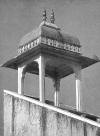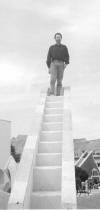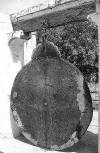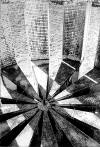The Medieval
Observatory at Jaipur, India
A Travelogue by
J. Christopher Westland
It is easy to forget, in this day of click-and-point computerized
telescopes, that calculating celestial positions was once an expensive, time
consuming, and uncertain process. It was also much more than an avocation for
middle aged professionals – it once engendered its own professional class of
court astrologers.
Throughout Europe and the Orient, from the medieval period through the 18th
century, judicial astrology – the use of astrology for political, medical
and personal decision making – played a pivotal role in life and government. In
the medical realm, astrology was more successful and highly regarded than the
medical care provided by physicians. This was a healthy prejudice at a time
when the physician's bag contained only a few crude tools – digitalis, heavy
metals, leeches, and so forth. Astrology was generally no less effective, and
certainly much safer, than a physician's nostrums.
Judicial astrology played an important decision making role in the court of
Mughal emperor Akbar. Akbar's rule created many opportunities for local
princes, consolidating his own power while keeping the well-armed British at
bay. Maharaja Sawai Jai Singh II benefited greatly under Akbar's rule. The
title Maharaja is equivalent 'king' in the West; the title Sawai
means '1.25 times superior to his contemporaries' (the precise significance of
the multiplier 1.25 has been lost to antiquity). Jai Singh was permitted to
maintain a large cavalry and infantry force, increasing his power and wealth
enormously through tax farming. By the time of his death in 1743, Jai Singh was
the single most important ruler in Rajasthan (now a state in western India).
Jaipur in eastern Rajasthan (earlier Amber) was named in honor of Jai
Singh. Even today, it is a place not often visited by Westerners or by Indians
from outside the region. Rajasthan – today little changed from the days of
Akbar – is a plain surrounded by mountains speckled with Akbar's huge marble
castles. Women in bright silk sashes walk twice daily to wells to collect
water, carrying huge bronze vessels on their heads. It is a land of shepherds,
dirt roads and medieval villages, where the main forms of locomotion are
elephant and camel.

Figure 1: At the well

Figure 2: Shepherds in the countryside Figure 3: Madame sash
The toolbox of Rajasthan's medieval astrologers consisted of only a few
instruments – a quadrant, sun-dial, astrolabe, stone
circle (consisting of monoliths reminiscent of Stonehenge in England) and a
simple sextant (the modern sextant was not invented until 1757, when
British sea captain John Campbell added mirrors to extend the range of a
quadrant to 120 degrees). Medieval astrologers knew well that 'size does
matter!' The larger the instruments, the greater their precision (in theory).
The Godzilla of medieval instruments is, without contest, the large sundial at
Jaipur, with a gnomon triangle of 44 meters by 27 meters (144 feet by 89
feet).

Figure 4: The Large Sundial (Brihat Samrat Yantra)

Figure 5: Observing Station of the Large Sundial
The Maharaja Jai Singh became intensely interested in astronomy during a
tense debate in 1719 at the court of Mughal emperor Mohammed Shah. At issue was
a trip on which the Emperor was planning to embark. Court astrologers could not
agree on the best date. The debate encouraged Jai Singh to set astrological
education as a priority in his kingdom. To that end, he constructed a series of
observatories, starting with Delhi (in 1724), followed by Varanasi, Ujjain,
Mathura and lastly Jaipur. The instruments are of unique design, though the
construction techniques and masonry followed Islamic practice used in mosques
and castles of the period.
Jai Singh's observatories are called Jantar Mantar – literally Instrument
Calculation. This Indian term for astronomical observatory derives from the
Sanskrit yantra or jantar, meaning 'instrument'; and mantra
(a term familiar to the West through the Transcendental Meditation movement)
which means 'mysterious formulae for calculations.' The observatory in Jaipur
is the largest in India, and is situated next to the City Palace in the center
of Jaipur. The huge instruments provide highly accurate measurement of time,
declination of the sun, altitude and azimuth of celestial objects, the positions
of the constellations for each day, eclipses and other astronomical events.

Figure 6: Jantar Mantar and City Palace
I had an opportunity to visit the astronomical observatory at Jaipur during
my recent travels through Rajasthan. After a short trip by elephant brought me
to Jaipur's City Palace, I proceeded (ducking hawkers along the way) toward Jai
Singh's eclectic collection of astronomical instruments. Under the
watchful eyes of monkeys that populate the observatory, I toured dozens of
ancient instruments.

Figure 7: Lumbering towards Jaipur
The Instruments
The Large and Small sun-dials
The small sundial is small only in comparison to other instruments; the
sundial's gnomon is actually a staircase of 30 steps inclined at 27 degrees (the
latitude of Jaipur). It is used to calculate the declination of celestial
objects. It has two quadrants on either side, which are inclined in the plane
of the celestial equator (23 degrees) with divisions that provide measurement
accuracy to 20 seconds. The shadow of the gnomon falls on the quadrants,
allowing the reading of local time.

Figure 9: At the Small Sundial

Figure 8: Monkeys peering over the observatory

Figure 10: On the gnomon of the small sundial
The large sundial is a ten-times scaled up version of the small sundial
(giving a precision of 2 seconds). The base of its gnomon is 44 meters long,
and rises 27 meters high, with quadrants of 15 meters radius. This is the only
instrument in use today, though its use can hardly be considered scientific.
Indian astrologers gather on the full moon days of June and July to study the
movement an direction of the wind, which they believe will help them forecast
the rains in the coming three months. For this purpose, a thin cloth flag is
hoisted precisely at sunset. If the flag indicates an easterly breeze, then
Rajasthan can expect good monsoons and healthy crops. If the wind is southern,
Rajasthan will experience a drought, with the potential for famine. Westerly
winds indicate the possibility of flooding, and northern winds indicate that
crops will be good. Despite the annual regularity of this ritual, there seems
to be little documentation concerning the accuracy of forecasts made in prior
years.

Figure 11: Front View of the Large Sundial
Zodiac Instruments
The Zodiac Instruments (Rashi Yantra; Rashi = Zodiac) are a group of
12 instruments, each used for a specific Zodiac sign. They look like diminutive
sundials. The quadrants of the sun-dials, though, are positioned on the
celestial equator, while the quadrants of the Zodiac Instruments are positioned
at the ecliptic at the moment of observation.

Figure 12: Rashi Yantra

Figure 13: Rashi Yantra
Jai's Instruments
The Jai Prakash Yantra (literally, Maharaja Jai's instrument) is an
intriguing instrument, designed by the Maharaja himself. It was used for
verifying the readings of other instruments. It consists of two concave
hemispherical marble bowls about 5.5 meters in diameter and representing the
celestial hemispheres turned upside down. These two cavities are divided into
six marble slabs, each engraved in minute and second graduations, marking the
location of the Zodiac signs. The middle of the instrument contains a metal
ring that identifies the position of the sun. The shadow of the sun falls
through the metal ring, onto the graduated surface. By day, the instrument
allows calculation of time; by night, observers sit inside the slabs of marble
and observe celestial objects through the hole in the metal ring. It is
intriguing and impressive to sit inside the slabs looking up. Unfortunately,
the park housing the observatory closes at 6:00 PM, making it difficult to try
out the instrument at night (nor am I sure I would have felt all that safe on
the streets of Jaipur after dark).
 Figure 14: Jai Prakash Yantra
Figure 14: Jai Prakash Yantra
 Figure 15: Jai Prakash Yantra
Figure 15: Jai Prakash Yantra
The Kapali Yantras are two similar bowl-shaped marble structures
situated on a masonry platform in the western extreme of the observatory. Their
horizons are calibrated from zero to 180 degrees, with the names of the twelve
Zodiac signs inscribed. The eastern Kapali is not used for observation, but for
solving astronomical problems graphically, with observations made by the western
Kapali – a diminutive version of the Jai Prakash Yantra.
The King
The name Yantra Raj means 'king of instruments.' I didn't find the
instrument very impressive, but it certainly seems to have captured the
attention of Jai Singh. It is an oversized astrolabe consisting of a metal
disk 2 meters in diameter, with engraved lines and circles, suspended from an
arch. The Maharaja
designed Yantra Raj, and wrote two volumes describing the use of the
instrument.

Figure 16: Yantra Raj
Stonehenge East
Two massive cylindrical structures resembling a streamlined Stonehenge – the
Ram Yantras – were used to calculate altitude and azimuth of celestial
objects. There is also and instrument for calculating azimuth called the
Digansha Yantra. The latter, instead of using Stonehenge style posts, uses
a metal graduations on large marble rings, lined up through a small metal
donut. It is used to calculate positions of celestial objects.

Figure 17: Ram Yantra

Figure 18: Ram Yantra

Figure 19: Digansha Yantra
Other Instruments
The Pole Star Instrument is made of red sandstone with a gnomon
inclined at 27 degrees (the latitude of Jaipur) and is used to locate Polaris.
The Narivalaya Yantra consists of two hemispherical sundials with a
precision of 1 minute, which also contain markings for locating the positions of
celestial objects. The Kantivrita Yantra rotates on a masonry base, and
consists of two metal frames used for measuring celestial latitude and
longitude. The Unnatansha Yantra is a large quadrant. There is also a
large unfinished instrument, which was started, then deemed unworkable. Park
management was mum on its intended function.

Figure 20: The Mysterious Instrument

Figure 21: Unnatansha Yantra

Figure 22: Kantivrita Yantra

Figure 23: Narivalaya Yantra











 Figure 14: Jai Prakash Yantra
Figure 14: Jai Prakash Yantra Figure 15: Jai Prakash Yantra
Figure 15: Jai Prakash Yantra






